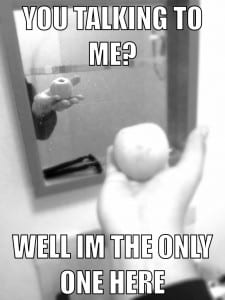Framing Statement
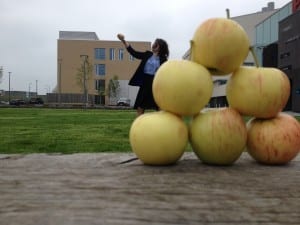 On May 10th 2014, Phil Munro, Kate Newman, Claudia Cross, Connor Mccue and I created our own piece of site specific theatre which was based or mostly influenced by the famous Isaac Newton when it was supposedly claimed that he theorised the notion of gravity immediately after an apple fell on his head from the tree. Our performance was based entirely on apples and we named it ‘101 things to do with an Apple’. Our first original title was to be The A team (which is a reference to the popular 80s TV show), but we decided to stick with the former as our title. At first, we wanted to recreate the entire Isaac newton story, laced with comedic and fictionalised acting. However, as we progressed more and more into our ideas, we instead decided to forget the acting and start doing. Many things we found to do with apples are mostly traditional and conventional things, but then wanted to steer off into the abstract and do thingsthat most people wouldn’t even dream of ever considering. It was a durational performance that evidently lasted around 4 to 5 hours with one break in between. The showing is to be the first of two as we are expected to perform at the Gravity Fields Festival in September. We was told that this festival was based around Newtonian science and we was to create something science based. We had a lot more freedom with the space at the Lincoln Performing Arts Centre, but I never really had the feeling that our performance was ‘site based’. We wanted to incorporate that feeling of decay and desolation into our piece. There was no talking throughout the entire performance as we felt that silence was a lot more authentic and related to the piece. We thought about audience participation from the start, but instead opted for audience reaction. I will discuss how our process went from trying to ‘act’ out our performance in the early stage, to creating a piece of art that enables one to go deeper within the boundaries of theatre as a whole.
On May 10th 2014, Phil Munro, Kate Newman, Claudia Cross, Connor Mccue and I created our own piece of site specific theatre which was based or mostly influenced by the famous Isaac Newton when it was supposedly claimed that he theorised the notion of gravity immediately after an apple fell on his head from the tree. Our performance was based entirely on apples and we named it ‘101 things to do with an Apple’. Our first original title was to be The A team (which is a reference to the popular 80s TV show), but we decided to stick with the former as our title. At first, we wanted to recreate the entire Isaac newton story, laced with comedic and fictionalised acting. However, as we progressed more and more into our ideas, we instead decided to forget the acting and start doing. Many things we found to do with apples are mostly traditional and conventional things, but then wanted to steer off into the abstract and do thingsthat most people wouldn’t even dream of ever considering. It was a durational performance that evidently lasted around 4 to 5 hours with one break in between. The showing is to be the first of two as we are expected to perform at the Gravity Fields Festival in September. We was told that this festival was based around Newtonian science and we was to create something science based. We had a lot more freedom with the space at the Lincoln Performing Arts Centre, but I never really had the feeling that our performance was ‘site based’. We wanted to incorporate that feeling of decay and desolation into our piece. There was no talking throughout the entire performance as we felt that silence was a lot more authentic and related to the piece. We thought about audience participation from the start, but instead opted for audience reaction. I will discuss how our process went from trying to ‘act’ out our performance in the early stage, to creating a piece of art that enables one to go deeper within the boundaries of theatre as a whole.
The Process
When we define the word ‘site’, we envision the term as a place that is built within this world. Site is everywhere; cities, houses, museums, shops and so forth are prime examples of how we perceive the term ‘site’. It is not classed as acting but it still stays in the lines of theatre, only to take away the conventional space like the stage. When we think of site specific, we determine the precise and clear space which will be transformed into a place of performing manoeuvres. As Mike Pearson says ‘In reflecting upon the specific relationship between place and performance, we might usefully borrow other disciplinary optics. We might realign such performance as an active agency within adjacent fields of endeavour: geography, architecture, urban planning.’ (2010, pp42). The world around us can be used as performance. We base site specific on those three key terms above and it forms the basis of specificity. In the first session, I already had an initial idea about how a performance could have been developed. As an avid video gamer I played the game Silent Hill: Downpour and something caught my eye. Seeing as our main goal was to create a performance that was based around science, I initially imagined the concept of lights and space being merged together. In that particular game, the main plot focuses on a supernatural town that has the ability to bring mannequins to life. In this essence, I thought about having performers play the mannequins and having this scientific element of light. I had the notion of the lights sort of ‘activating’ the mannequins with the latter coming to life with only the flick of a switch. As another form of research, I watched the 2007 film Sunshine to gain an understanding of the scientific elements.
‘Our sun is dying. Mankind faces extinction. Seven years ago the Icarus project sent a mission to restart the sun but that mission was lost before it reached the star. Sixteen months ago, I, Robert Capa and a crew of seven left earth frozen in a solar winter. Our payload a stellar bomb with a mass equivalent to Manhattan Island. Our purpose, to create a star within a star’. (Boyle, 2007).
This film was more of an encouraging thought process about the solar system and natural light. There is a very highlighting scene that struck me the most scientifically, when the protagonist sacrifices his life to activate the bomb and for moment before he dies he is sandwiched between a nature and science. This made me wonder about the kind of light we can reference in a performance. Physicist Brian Cox points out that ‘heat is a form of light although we don’t call it light’. (BBC, 2011). Seeing as the Gravity Fields Festival is based solely on scientific collaboration, I wanted to exam a way in which science and human nature is linked. Instead, our group decided that we should scrap the idea of light and sound and focus solely on the history of Isaac newton and the gravity theory.
We watched several videos of site specific performances one day to get some initial thoughts and ideas about the style of performing we were going to craft. The one performance that was interesting to me was Yoko Ono’s piece titled Cut Piece. In 1965, Ono sat on a stage in a dress and invited members of the audience to come and cut a small piece of her clothing one at a time. As the performance went on, the more naked she would become. This piece partially inspired me as a performer to pay close attention to spectators who have been asked to interact with the person who is performing. In this case, it still shocks people to this day how much a few of spectators became more of the ‘eager beavers’ when she was close to getting naked. I felt this piece conveyed a powerful message about the psychological interaction with the seemingly vulnerable performer and the eager audience.
In the early development stages, one of the key requirements that was expected was to understand how to draw an audience in. With having the mind-set of performing in empty shops, we had to grasp the concept of performer/audience relationship. For example, how would a performance that appears to be something so basic manage to engage with the audience’s expectations? Well according to the book Performance Analysis, ‘the viewer performing interpretative acts predicted by the viewed, while the viewed itself- the object as it is perceived- is in turn constructed, endowed with meaning in the gaze of the viewer’. (Counsell and Wolf, 2001, pp178). What they are trying to examine here is how the performer has a purpose to fulfil to an audience which was one of main goals within our group. Eventually our performing space was no longer going to be in the shops, but in the LPAC. So we already knew our initial target audience would be students and adults. As for Grantham, the audience dynamic would have drastically switched because it would have been families and everyday members of the public. This sudden change took an impact on our ideas at first, but eventually we managed to carefully put things together. But we valued the idea of how Site Specific stretches beyond the possible and it helped to begin to understand what kind of audience we are trying to convince here.
In theory, apples belong to a specific ‘place’ which is the tree they grew from. Nonetheless, I thought about the idea of how we are giving apples the space to perform. It is their show, they are the artists, and they are have taken the stage. We, as performers have given them the time to shine, use the place they were born from to their advantage to showcase their skills.
I took this picture to reflect on how we were going to enable these apples to take centre stage. I used this quote spoken by Robert De Niro’s character Travis Bickle in the famous 1976 Martin Scorsese movie Taxi Driver, which has gone down in the history of cinema. I chose to use this particular quote because I wanted to understand the key element within the mainframe of site specific, which is to take something from its real life and turn it on its head in the form of real life art. The popular culture reference is a way of recreating something that is fictional and making is as a simple thing you could do with an apple: The Apple staring into the mirror, looking at itself, implies that it is being given a status, but this does its best to maintain its form of space. ‘High status players (like high- status seagulls) will allow their space to flow into other people. Low status players will avoid letting their space flow into other people’. (Johnstone, 1981, pp59). This values the aspiration for the apple taking the space and the people (the performers), who give them that moment of creativity. The mirror represents the apple assembling its place in society and looking deeper within themselves. Time was to be a part of our installation because of how long we wanted to take in performing the tasks at hand. We stuck to the idea of taking as much time as possible. There was no rush. The first ever thing that was done with an apple was to film it over a period of time rotting. The visual element of the video itself looks very abstract and this happened to connect with our idea of having a decayed environment as a performance space, as well as our duration. This video is an example of how we wanted to identify the core elements of a clattered environment. The time lapse effect shows just how effective and visualising the piece of fruit looks as it goes mouldy over the months. In the context of our performance, the space and time is merged to create a surreal image of what things we can do with an apple. As this was the first time I had done something like this, I always thought about the charisma and spatial awareness of the whole performance. As an inspiration, I was watching videos on professional magician and endurance artist David Blaine. He is a key example of somebody who uses the city as their performing playground with his illustrious techniques. In the 2013 TV show Real or Magic, Blaine attempted to show celebrities magic that borders the realms of reality and how the impossible seems possible. ‘Most believe that the greatest trick a magician can do was to convince the world that the impossible is real’ (Blaine, 2013). For years, he has specialised in wowing the public with his artistic craft. Many reactions to his magic sound like ‘oh my god’ or ‘that’s impossible’. One funny reaction in this show in particular was from Harrison Ford, who promptly told Blaine to get out of his house after witnessing a card trick. Blaine’s energetic presence is what drove me to understand how our place as performers is giving solely to us to rectify. We give the audience our benefit of believability and in turn they are drawn in to what they are watching. In this instance, Blaine attempts to cross the line between what is real and what is simply an illusion. Lyn Gardner believes that ‘these days “site specific” can be just about anything that doesn’t happen in a theatre’ (The Guardian, 2009). I partially agree with Gardner’s notion that site specific can likely be a standard performance outside normal theatre. However, in terms of the authenticity of site, she’s wrong about the performance being ‘anything’ but real life integrity. In terms of place, everyone has one. This place is what gives us freedom to move and think, to live and breathe. Our visit to 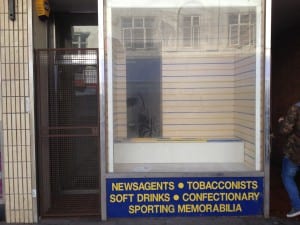
Grantham gave us more of a range of ideas about how we can pull something like this off. We looked at a few empty shops but this empty newsagent it’s what we wanted the moment we looked into the dirty windows. This shop in particular gave off a realistic sense of knowing how to establish our place within the site spectrum and how it would easily relate to our subject matter.
The renowned theatre group ‘Blast Theory’ had created a multimedia based performance called Can You See Me Now and this was a source of inspiration to understand the concept of everyday performance in the real world. The piece was solely based on virtual reality and uses a video game style method to use the city as a form of absence and presence. It would represent the relationship between the real life performers, whose job was to find the ‘gamer’ who was logged into the virtual version of the real city. ‘By sharing the same space, the players online and runners on the street enter into a relationship that is adversarial, playful and ultimately, filled with pathos’ (Blast Theory, 2013). So the city has created an opening for gaps to be filled with players and spectators. ‘When we perform alone, a part of the self stands aside, appreciating and evaluating what we do.’ (Tuan, 2001, pp161). In this sense, the players are the runners on the streets and the spectators are members of the public who can sign up to play. This idea of making the space our own, is what helped the creative aspects morph together. It helped motivate our goal to create an easy and simplistic performance, which makes the audience want to either get involved or in this case, just be engaged with the style and narrative of our context. In my opinion, I believe site isn’t just about performing outside the normal realm of traditional theatre, but it is more of a way to interject what we see in the real world and use it to our own advantage as a way to perform.
Performance Evaluation
After weeks of a challenging preparation process, our performance was a success because we finally accomplished many of the things we wanted from the start of the project, although some things were changed drastically in the last few days before.
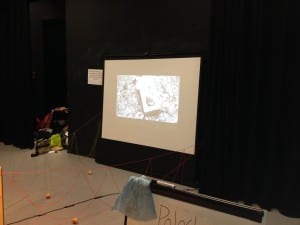
During the performance, our ideas came to life with an hour long video of many of the things we had done with apples set up as the installation. Seeing as we had a relatively large studio space to perform in, we used that to our advantage and managed to create the cluttered and broken down environment we envisioned from the very beginning. Audience members were free to come and go as they please, although about 15 people altogether throughout the day came along to see it. We printed off a checklist for them to collect to take around with them in our performance space. Their objective was to try and tick off all the things that can be done with apples and I was very surprised at some of the responses. Around 3 or 4 people actually found many of the things on our list but some missed it. The idea was to enable them not to interact with the performers, but to look around at the space carefully.
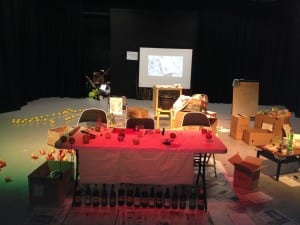
We even had one overzealous member of the audience who just came into the room and sat down in our set trying to cut apples. We had to tell him to not touch the set, but what was interesting was how someone so curious would want to impulsively interject themselves into our performance space. That sums up how we didn’t want full on audience participation, but we should have prepared to expect the unexpected.
What I think worked well the most was the video we had playing on the projector screen. It was roughly an hour long video that was played on loop. It had about 80 things that was done with apples as well as well as the decaying time lapse apple. Another performance aspect that worked well was the energy of our group. At first, we never thought we could manage to pull of something this abstract, but it became easier when we discovered that only movement and action was the key ingredient. We weren’t trying to portray characters that are doing things with apples, but we as ordinary people were just trying to show people that we want to take a real life element and expand its horizons. We had a white board and a bell in which whenever it was rung somebody or a couple will take the stage and perform something with an apple or apples. Days before performance, we had an order which was to be carried out as in who goes up when. On the day, we decided that it wouldn’t matter what order we go up in or who performs first because we wanted to relate more to out cluttered set so instead we let it flow however it flowed. Improvement wise, I think we could have used or added more things to the space and anything we printed out that was used around the space such as apple facts or Steve Jobs quotes, could have been laminated to reflect the realism or quality of the performance. Another improvement I would add to the piece would be more of the history of Isaac Newton. I felt that if we had the story of Newton’s theory incorporated more into our work, then it would give the audience much more of an understanding of what the influence and history of our context was. If I could change one tiny detail of our performance and I believe my group would agree is the way the bell that we used to ‘activate’ us, could be left to the audience to ring it. But this would require a prompt or sign to alert the spectators of some kind. I hope that I will have more of a feel for the real site in September. Only then will I have learned one of the true elements of site specific performance in general: the Site itself.
Overall, site specific performance has been by far one of the most difficult subjects I’ve ever been taught as a trainee actor. But what I have learnt is that I have been too blind to see that performance stretches way beyond acting and it throws reality into the mix. Or better yet, reality is the performance.
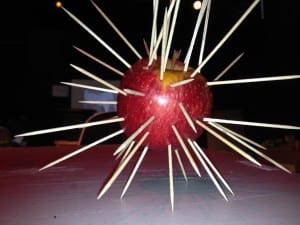
Bibliography
Blaine. D (2013) David Blaine: Real or Magic. [online video] available from: https://www.youtube.com/watch?v=RAiWABRx9tM [accessed 12th may 2014].
Blast theory (2001) Can You See Me Now. [online] Brighton available from: http://www.blasttheory.co.uk/projects/can-you-see-me-now/ [accessed 14th may 2014].
Boyle. D. (dir.) (2007) Sunshine. [Film] Fox Searchlight Pictures.
Counsell. C, Wolf. L (eds.) (2001) Performance Analysis: an introductory coursebook. New York: Routledge.
Gardner. L. (2008) Site specific theatre: please be more specific [blog entry] 6 February. The Guardian. Available from: http://www.theguardian.com/stage/theatreblog/2008/feb/06/sitespecifictheatrepleasebe [accessed April 20th 2014].
Johnstone. K. (1981) Impro: Improvisation and the theatre. London: Methuen drama.
Joseph, N. (2014) 101 things to do with an Apple. [photos] Lincoln and Grantham: Lincoln Performing Arts Centre
Ono. Y. (1965) Cut piece [online video] available from: https://www.youtube.com/watch?v=8Sc47KfJjcI [accessed 13th may 2014].
101 Things to do with an Apple. [performance.] Lincoln: Lincoln Performing Arts Centre.
Pearson. M (2010) Site Specific Performance. London: Palgrave Macmillan
Tuan, Fu -Y. (2001) Enacting Space. In: Colin Counsell and Laurie Wolf (eds) Performance Analysis: an introductory coursebook. New York: Routledge.
Wonders of the universe (2011) [online] BBC. 28 March. Available from http://www.bbc.co.uk/programmes/p00fz68w [accessed 16th march 2014].

